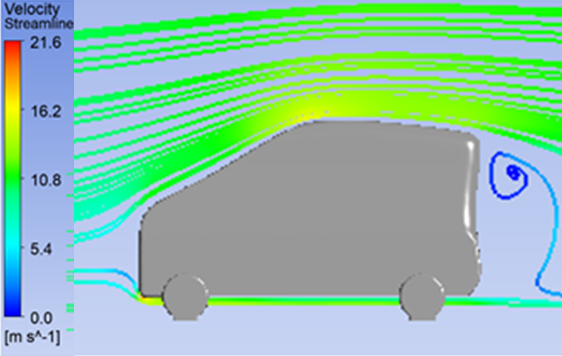Main Article Content
Abstract
A city car is needed to overcome congestion and parking spaces in urban areas. However, currently, the body design of the city car is still experiencing problems, namely the value of the large drag coefficient, which causes an increase in fuel consumption. This study aims to design a city car body with two passengers that is more aerodynamic so as to minimize fuel use. This research method is a numerical simulation model using the ANSYS fluent students version 2021. Parameters in the form of drag coefficient values, velocity streamlines and velocity contours on the city car are aerodynamic aspects that are analyzed. The results show that the dimensions of the designed city car have a length of 2.59 m, a width of 1.6 m, and a height of 1.52 m by considering the ergonomic parameters and comfort of the user so that it fits the character of the people in Indonesia. In addition, from the independence grid analysis performed, the value of the number of meshes that have the smallest error value is obtained, namely mesh C (the number of meshes is 129,635). Mesh C has an error of 7.2%. It was found that as the velocity increases, the value of the drag coefficient (CD) produced is relatively smaller. In a city car with a velocity of 10 m/s, the drag coefficient value is 0.599, at a velocity of 20 m/s, the drag coefficient value is 0.594, and a velocity of 30 m/s is a drag coefficient value of 0.591.
Keywords
Article Details

This work is licensed under a Creative Commons Attribution-NonCommercial 4.0 International License.
References
- UK Department for transport, “Road Use Statistics GB 2016,” JPEN. Journal of parenteral and enteral nutrition, vol. 3, no. 6, pp. 452–6, 2016.
- Public Works and Housing Ministry, “Indonesian Insfrastructure Statistics,” Pusdatin, vol. 53, no. 9, pp. 1–58, 2020.
- S. Selzer and M. Lanzendorf, “On the road to sustainable urban and transport development in the automobile society? Traced narratives of car-reduced neighborhoods,” Sustainability (Switzerland), vol. 11, no. 16, 2019, doi: 10.3390/su11164375.
- D. Shoup, Parking and the City, no. July. 2018.
- D. W. Karmiadji, M. Gozali, M. Setiyo, T. Raja, and T. A. Purnomo, “Comprehensive Analysis of Minibuses Gravity Center: A Post-Production Review for Car Body Industry,” Mechanical Engineering for Society and Industry, vol. 1, no. 1, pp. 31–40, 2021, doi: 10.31603/mesi.5250.
- A. Gussmann, “Analysis of the applicability of a mobility concept without private cars for the Maun Science Park Botswana,” 2010.
- A. Ekoprianto, “Analisis Aerodinamika Pada Mobil Listrik Type Citycar Untuk Lingkungan Kampus,” Jurnal Konversi Energi dan Manufaktur, vol. 3, pp. 125–130, 2016.
- F. Mariani, C. Poggiani, F. Risi, and L. Scappaticci, “Formula-SAE racing car: Experimental and numerical analysis of the external aerodynamics.,” Energy Procedia, vol. 81, pp. 1013–1029, 2015, doi: 10.1016/j.egypro.2015.12.111.
- A. Yudianto, I. W. Adiyasa, and A. Yudantoko, “Aerodynamics of Bus Platooning under Crosswind,” Automotive Experiences, vol. 4, no. 3, pp. 119–130, 2021, doi: https://doi.org/10.31603/ae.5298.
- R. E. M. Nasir et al., “Aerodynamics of ARTeC’s PEC 2011 EMo-C car,” Procedia Engineering, vol. 41, no. Iris, pp. 1775–1780, 2012, doi: 10.1016/j.proeng.2012.07.382.
- Z. M. Saleh and A. H. Ali, “Numerical Investigation of Drag Reduction Techniques in a Car Model,” IOP Conference Series: Materials Science and Engineering, vol. 671, no. 1, 2020, doi: 10.1088/1757-899X/671/1/012160.
- A. Huminic and G. Huminic, “Aerodynamics of curved underbody diffusers using CFD,” J. Wind Eng. Ind. Aerodyn., vol. 205, p. 104300, 2020, doi: 10.1016/j.jweia.2020.104300.
- P. A. Nigal Ashik, P. Suseendhar, N. Manoj, and S. Wasim Feroze, “Reduction of drag in box-type and half streamlined automobile vehicles,” Materials Today: Proceedings, no. xxxx, 2020, doi: 10.1016/j.matpr.2020.11.109.
- G. Sivaraj, K. M. Parammasivam, M. S. Prasath, P. Vadivelu, and D. Lakshmanan, “Low analysis of rear end body shape of the vehicle for better aerodynamic performance,” Materials Today: Proceedings, vol. 47, no. xxxx, pp. 2175–2181, 2021, doi: 10.1016/j.matpr.2021.05.521.
- J. Carvill, “4 - Fluid mechanics,” J. B. T.-M. E. D. H. Carvill, Ed. Oxford: Butterworth-Heinemann, 1993, pp. 146–171.
- R. P. Putra, Sutardi, and W. A. Widodo, “Experimental and numerical studies of pressure drop reduction in a 90° square elbow with the addition of circular turbulators,” Int. Rev. Mech. Eng., vol. 13, no. 10, pp. 608–618, 2019, doi: 10.15866/ireme.v13i10.18148.
- X. Hu, R. Zhang, J. Ye, X. Yan, and Z. Zhao, “Influence of different diffuser angle on Sedan’s aerodynamic characteristics,” Physics Procedia, vol. 22, pp. 239–245, 2011, doi: 10.1016/j.phpro.2011.11.038.
- A. Huminic and G. Huminic, “Aerodynamic Study of A Generic Car Model With Wheels and Underbody Diffuser,” International Journal of Automotive Technology, vol. 18, no. 3, p. 397−404, 2017.
- G. Rossitto, C. Sicot, V. Ferrand, J. Borée, and F. Harambat, “Aerodynamic performances of rounded fastback vehicle,” Proceedings of the Institution of Mechanical Engineers, Part D: Journal of Automobile Engineering, vol. 231, no. 9, pp. 1211–1221, 2017, doi: 10.1177/0954407016681684.
- P. Kekus and D. Angland, “Automatic wind tunnel-based optimisation of an automotive underbody diffuser,” AIAA Aerospace Sciences Meeting, 2018, no. 210059, 2018, doi: 10.2514/6.2018-0045.
- O. H. Ehirim, K. Knowles, and A. J. Saddington, “A review of ground-effect diffuser aerodynamics,” Journal of Fluids Engineering, Transactions of the ASME, vol. 141, no. 2, pp. 1–19, 2018, doi: 10.1115/1.4040501.
- M. Grandemange et al., “A study of wake effects on the drag of Ahmed’s squareback model at the industrial scale,” Journal of Wind Engineering and Industrial Aerodynamics, vol. 145, pp. 282–291, 2015, doi: 10.1016/j.jweia.2015.03.004.
- G. Bonnavion and O. Cadot, “Boat-tail effects on the global wake dynamics of a flat-backed body with rectangular section,” Journal of Fluids and Structures, vol. 89, no. 2018, pp. 61–71, 2019, doi: 10.1016/j.jfluidstructs.2019.01.009.

